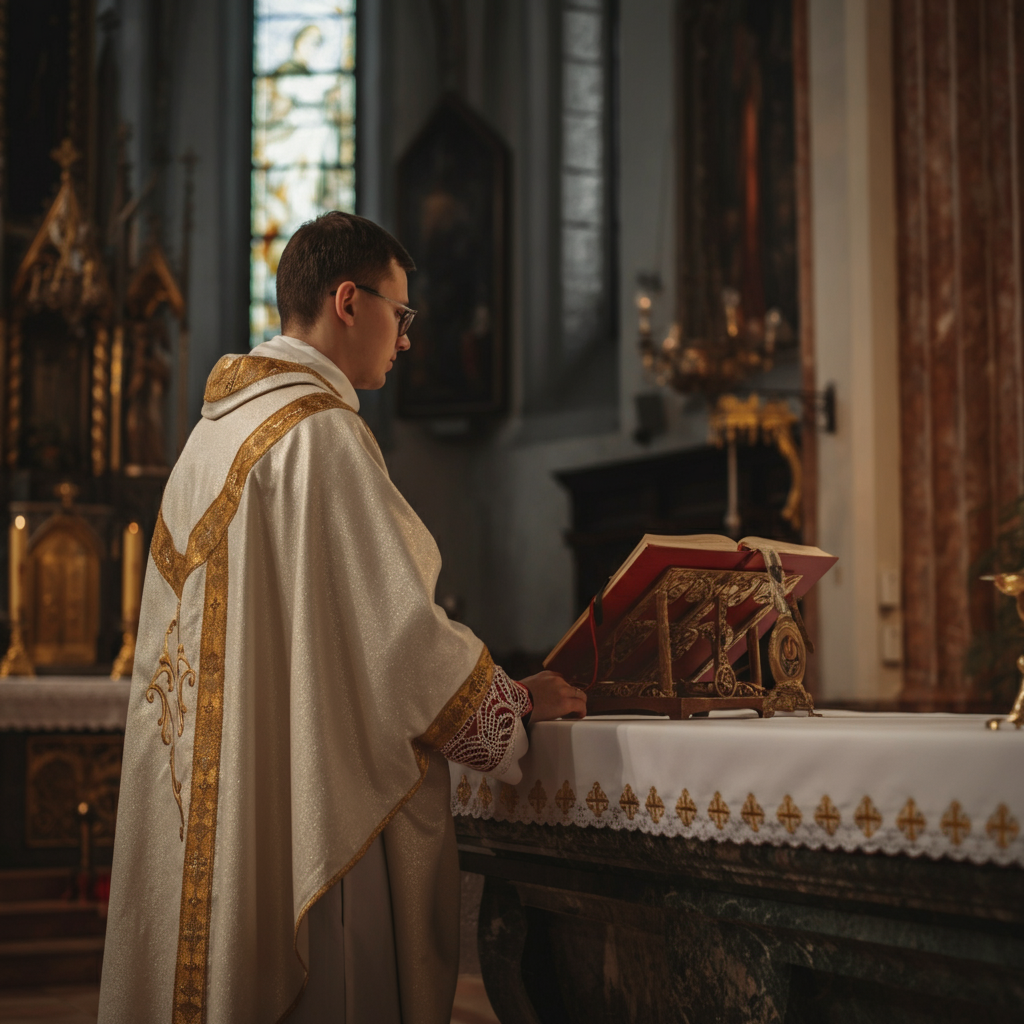Have you ever wondered about the meaning behind a priest outfit? For many, the image of a priest is instantly recognizable, largely due to their distinctive clothing. These garments, known as clericals or vestments, are more than just a uniform. They are steeped in history, symbolism, and tradition, telling a story that spans centuries.
This guide will explore the fascinating world of the priest outfit. We’ll look at the different pieces, what they represent, and how they vary across denominations. Whether you’re curious about religious traditions, need information for a creative project, or are simply interested in the history of clothing, you’ll find the answers here. We will cover everything from the daily cassock to the elaborate vestments worn during special services.
Key Takeaways
- A priest’s clothing is divided into two main categories: daily clerical wear and liturgical vestments for services.
- Each piece of the priest outfit, from the cassock to the chasuble, holds deep symbolic meaning related to faith, service, and humility.
- The colors of vestments change throughout the liturgical year to reflect the specific season or celebration.
- While there are many similarities, the specifics of a priest outfit can vary between different Christian denominations like Catholic, Orthodox, and Anglican.
Understanding the Basics of Clerical Attire
A priest’s wardrobe is typically split into two categories. The first is the everyday clothing, often called “clericals.” This is what a priest might wear while performing daily duties outside of a formal church service. The most common example is the black shirt with a white rectangular tab at the collar. The second category is liturgical vestments, which are the special robes and garments worn during worship services like Mass.
These vestments are not just for show. They serve a practical and spiritual purpose. Spiritually, they separate the sacred act of worship from ordinary life. They also visually connect the priest to the long line of clergy who have come before them, creating a sense of continuity and tradition. On a practical level, the distinct attire makes it clear who is leading the service.
The History Behind the Priest Outfit
The origins of the priest outfit are not as “holy” as one might think. In the early days of Christianity, clergy wore the same clothing as everyone else. Their attire was simply the formal dress of the Roman Empire. This included a tunic, a type of long shirt, and an outer cloak. As secular fashions changed over the centuries, the church’s attire did not.
This resistance to change meant that by the 6th century, clerical clothing started to look very different from everyday wear. The church decided to keep this older style of dress to signify the clergy’s separation from worldly concerns. Over time, these ancient Roman garments evolved into the specialized vestments we see today. Each piece was given a specific symbolic meaning, transforming them from simple clothes into tools of faith. For more fascinating clothing histories, you can explore articles on truefashionstory.comBlog.
Everyday Clerical Clothing
When not leading a service, priests wear specific clothing to identify their role in the community. This daily attire is less ornate than liturgical vestments but is equally significant.
The Clerical Collar
The most iconic piece of a priest’s daily wear is the clerical collar. This stiff, white band worn around the neck is a clear symbol of ministry. It comes in two main styles: the tab collar and the full band collar.
- The Tab Collar: This is the most common style seen today. It’s a small white square that shows through a special black shirt, often called a “clergy shirt.” It’s convenient and widely recognized.
- The Full Band Collar (or “Dog Collar”): This is a full ring of white plastic or linen that fastens at the back of the neck. It provides a continuous white line and is considered more traditional by some.
The collar itself symbolizes a priest’s commitment and service to God. It can be seen as a “yoke of service,” reminding the wearer and the community of their religious vows.
The Cassock or Soutane
The cassock, also known as a soutane, is a long, close-fitting garment that is a staple of the priest outfit. It is typically black for priests, but bishops may wear purple, and cardinals wear red. The Pope famously wears a white cassock. This long robe is not a liturgical vestment itself but is the foundational clerical garment worn both during services (under vestments) and for daily activities.
The cassock is usually ankle-length and has 33 buttons, traditionally said to represent the 33 years of Jesus Christ’s life. While many priests now opt for a simpler clergy shirt and trousers for daily wear, the cassock remains a powerful symbol of priesthood and is required for many formal occasions.
The Liturgical Vestments of the Catholic Church
During Mass and other religious ceremonies, a priest wears several layers of special clothing called vestments. Each piece has a unique name and purpose. Let’s break down the main components of a Roman Catholic priest’s vestments.
The Alb
The first vestment a priest puts on is the alb. The name comes from the Latin word albus, meaning “white.” It is a long, white linen robe that covers the body from the neck to the ankles. The alb symbolizes the purity of heart and baptismal grace required to approach the altar of God. It is a reminder of the white garment given during the sacrament of Baptism.
The Stole
Over the alb, the priest wears a stole. This is a long, narrow strip of cloth worn over the shoulders, like a scarf. It is the primary symbol of the ordained ministry. The color of the stole matches the liturgical season or the specific celebration. A priest wears the stole hanging straight down in the front, while a deacon wears it over their left shoulder and draped across the body to the right hip.
The Chasuble
The outermost and most visible vestment is the chasuble. This sleeveless outer garment is put on over all the others. The chasuble is the vestment most associated with the celebration of the Mass. Its color, like the stole’s, changes based on the liturgical calendar. The shape of the chasuble has evolved over time, from a large, conical garment to the more modern, streamlined designs seen today. It symbolizes the virtue of charity and the yoke of Christ.
Comparing Key Vestments
|
Vestment |
Description |
Symbolism |
|---|---|---|
|
Alb |
A long white robe, the foundational garment. |
Baptismal purity, new life in Christ. |
|
Stole |
A long, scarf-like cloth worn over the shoulders. |
Ordained authority, the yoke of service. |
|
Chasuble |
The sleeveless, colorful outer garment. |
Charity, the all-encompassing love of God. |
The Meaning of Liturgical Colors
The colors of the chasuble and stole are not chosen at random. They follow a specific cycle throughout the year, adding another layer of symbolism to the priest outfit. Each color is chosen to evoke a particular mood or theme related to the season.
Green
This is the color used for “Ordinary Time,” the periods of the year that fall outside of the major liturgical seasons. Green symbolizes hope, life, and anticipation for the return of Christ.
White or Gold
These colors are used for celebrations of great joy, such as Christmas, Easter, and major feast days. White and gold represent purity, light, glory, and triumph.
Red
Red is the color of passion and blood. It is worn on Palm Sunday, Good Friday, and the feast days of martyrs. It is also used for Pentecost, symbolizing the fire of the Holy Spirit.
Violet or Purple
This is the color of penance, preparation, and sacrifice. It is used during the seasons of Advent (in anticipation of Christmas) and Lent (in preparation for Easter).
Rose
Rose is used on only two days of the year: Gaudete Sunday (the third Sunday of Advent) and Laetare Sunday (the fourth Sunday of Lent). It signifies a moment of joy and anticipation in the middle of a penitential season.
Variations in Other Denominations
While many Christian denominations share a common heritage, there are distinct differences in their clerical attire. The priest outfit you see in an Orthodox church, for instance, will look quite different from one in an Anglican parish.
Orthodox Priest Attire
The vestments of an Orthodox priest are rooted in Byzantine tradition. Their everyday wear often includes a black cassock called an exorason or ryasa. During services, their vestments are often more ornate and feature different pieces. Instead of a chasuble, they wear a phelonion, a large, conical, cape-like garment. They also wear a distinctive vestment called the epitrachelion, which is their version of the stole, but with the two strips sewn together in the front.
Anglican Priest Attire
The Anglican Church, having its roots in the Church of England, has a tradition that often mirrors Roman Catholic practices. Many Anglican priests wear the same types of vestments: alb, stole, and chasuble. However, there is a wider range of practices. Some more traditional or “High Church” parishes use vestments very similar to Catholics, while “Low Church” parishes might opt for a simpler style, sometimes consisting of just a cassock, a surplice (a white, wide-sleeved tunic), and a stole. This diversity reflects the broad theological spectrum within the Anglican Communion.
Conclusion
The priest outfit is a rich tapestry of history, faith, and symbolism. From the simple clerical collar to the ornate chasuble, each element serves a purpose far beyond simple identification. These garments connect the present-day clergy to centuries of tradition and visually communicate the sacred nature of their work.
Understanding the meaning behind these vestments offers a deeper appreciation for the rituals and traditions of Christian worship. It shows how clothing can transcend fashion to become a powerful expression of belief and identity. The next time you see a priest, you’ll have a better understanding of the story their clothing tells—a story of service, sacrifice, and enduring faith.
Frequently Asked Questions (FAQ)
Q1: Why do priests wear black?
Priests typically wear black as a symbol of simplicity, sobriety, and mourning for sin. It signifies that they are “dead” to worldly ambitions and are dedicated to serving God. The black color also serves as a stark contrast to the white collar, which represents purity and the light of Christ.
Q2: Can a priest wear a regular suit?
Outside of their official duties, a priest can wear regular civilian clothing. However, when acting in their official capacity, even in a non-liturgical setting, they are often encouraged or required to wear their clericals (like the clergy shirt and collar) to remain identifiable as a priest.
Q3: Do all Christian ministers wear these outfits?
No. The use of specific vestments varies widely among Christian denominations. While Catholic, Orthodox, and many Anglican and Lutheran churches have a strong tradition of vestments, many Protestant denominations, such as Baptists, Evangelicals, and Pentecostals, do not use them. Their pastors often wear a simple suit or casual clothes.





